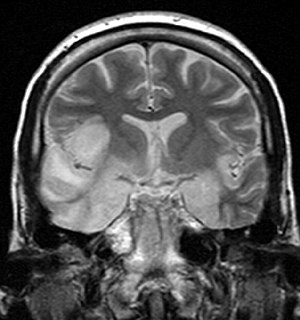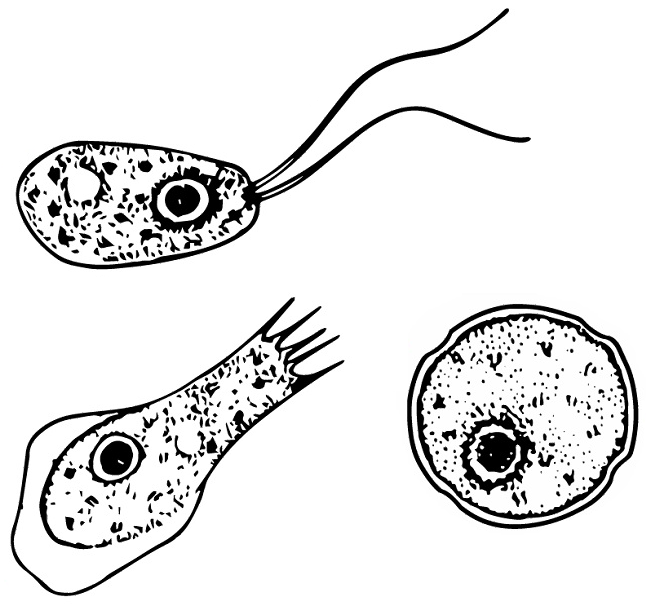This page is based on this
Wikipedia article Text is available under the
CC BY-SA 4.0 license; additional terms may apply.
Images, videos and audio are available under their respective licenses.

Encephalitis is inflammation of the brain. Severity is variable. Symptoms may include headache, fever, confusion, a stiff neck, and vomiting. Complications may include seizures, hallucinations, trouble speaking, memory problems, and problems with hearing.
Free-living amoebae in the Amoebozoa group are important causes of disease in humans and animals.
Viral encephalitis is a type of encephalitis caused by a virus.
ICD-10 is an international statistical classification used in health care and related industries.

Meningoencephalitis, also known as herpes meningoencephalitis, is a medical condition that simultaneously resembles both meningitis, which is an infection or inflammation of the meninges, and encephalitis, which is an infection or inflammation of the brain.
Balamuthia mandrillaris is a free-living amoeba that is known to cause the deadly neurological condition known as granulomatous amoebic encephalitis (GAE). B. mandrillaris is found in the soil and water and was first discovered in 1986 in the brain of a baboon that died in the San Diego Wild Animal Park. B. mandrillaris can infect the body through skin wounds or by inhaling the dust containing Balamuthia. Balamuthia has been isolated in nature. It is believed to be distributed throughout the temperate regions of the world. This is supported somewhat by the presence of antibodies to Balamuthia present in healthy individuals. The genus name Balamuthia was given by Govinda Visvesvara, in honor of his late mentor, the renowned parasitologist William Balamuth (1914–1981) for his contributions to the studies of parasitic and free-living amoebae. It was in 1993 when Visvesvara isolated and studied the pathogen for the first time.
The nickname "brain-eating amoeba" may refer to:
The Central Nervous System controls most of the functions of the body and mind. It comprises the brain, spinal cord and the nerve fibers that branch off to all parts of the body. The Central Nervous System viral diseases are caused by viruses that attack the CNS. Existing and emerging viral CNS infections are major sources of human morbidity and mortality. Virus infections usually begin in the peripheral tissues, and can invade the mammalian system by spreading into the peripheral nervous system and more rarely the CNS. CNS is protected by effective immune responses and multi-layer barriers, but some viruses enter with high-efficiency through the bloodstream and some by directly infecting the nerves that innervate the tissues. Most viruses that enter can be opportunistic and accidental pathogens, but some like herpes viruses and rabies virus have evolved in time to enter the nervous system efficiently, by exploiting the neuronal cell biology. While acute viral diseases come on quickly, chronic viral conditions have long incubation periods inside the body. Their symptoms develop slowly and follow a progressive, fatal course.
Human parasites include various protozoa and worms which may infect humans that cause parasitic diseases.

Amoebiasis, also known amoebic dysentery, is an infection caused by any of the amobae of the Entamoeba group. Symptoms are most common during infection by Entamoeba histolytica. Amoebiasis can be present with no, mild, or severe symptoms. Symptoms may include abdominal pain, diarrhea, or bloody diarrhea. Complications can include inflammation and ulceration of the colon with tissue death or perforation, which may result in peritonitis. People affected may develop anemia due to loss of blood.
Amebic encephalitis may refer to:
Sappinia diploidea is a free-living amoeba species.
An amoebic brain abscess is a brain abscess caused by amoebas. It is particularly serious in patients with immunodeficiency. It is very rare; the first case was reported in 1849.
Sappinia amoebic encephalitis (SAE) is the name for amoebic encephalitis caused by species of Sappinia.

Naegleria fowleri, colloquially known as the "brain-eating amoeba", is a species of the genus Naegleria, belonging to the phylum Percolozoa. It is a free-living, bacteria-eating amoeba that can be pathogenic, causing a fulminant brain infection called naegleriasis, also known as primary amoebic meningoencephalitis (PAM). This microorganism is typically found in bodies of warm freshwater, such as ponds, lakes, rivers, and hot springs. It is also found in the soil near warm-water discharges of industrial plants, and in unchlorinated or minimally-chlorinated swimming pools. It can be seen in either an amoeboid or temporary flagellate stage.




